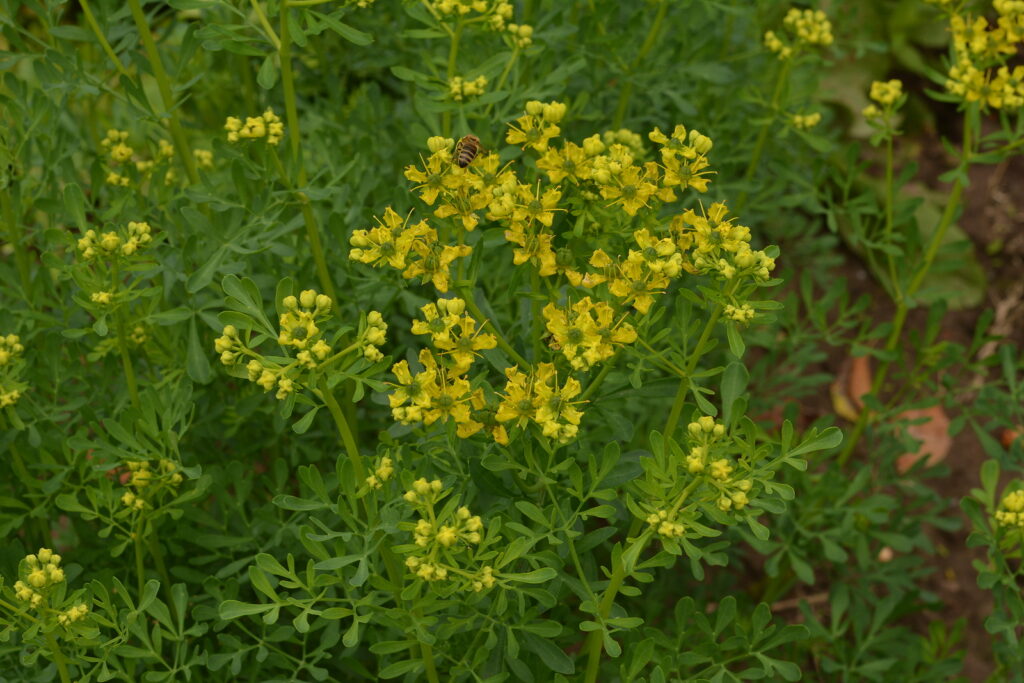Rue is a herbaceous perennial subshrub plant that is typically grown for its aromatic foliage and small, yellow flowers. Rue is known for its strong, aromatic scent and bright yellow flowers. It typically grows to be about 2 to 3 feet tall and wide. The plant produces small, yellow flowers in clusters, which mature into small fruits that resemble capsules. Rue has a strong, distinct aroma that is often described as unpleasant or medicinal.
Rue, botanical name Ruta, has gray-green, feathery leaves that are deeply divided and give off a musky odor when crushed. It is known for its historical association with protection and warding off evil spirits. In the past. It was used in medieval times to ward off the plague and is still believed by some cultures to have protective properties. In terms of medicinal uses, rue has been used traditionally to treat a variety of ailments such as headaches, menstrual irregularities, digestion problems, and joint pain. However, its use in herbal medicine is not as common today due to its potential toxic properties when consumed in high doses. It is important to note that rue can be toxic if ingested in large quantities and can cause skin irritation in some individuals.
Rue is native to Southern Europe. Rue is also cultivated in other parts of the world for its ornamental and medicinal purposes.

Get to know Rue – Ruta
- Plant type: Evergreen perennials and shrubs
- Growing zones and range: Zone 4 to 9
- Hardiness: Plants can die back in a freezing weather
- Height and width: 2 to 3 feet tall and wide
- Foliage: Pungent blue-green leaves, divided and ferny
- Flowers: Tiny greenish yellow leaves in flat clusters
- Bloom time: Midsummer
- Uses: Herb garden, perennial borders
- Common name: Rue
- Botanical name: Ruta
- Family name: Rutaceae
- Origin: Southern Europe
Where to plant Rue – Ruta
- Rue plants prefer full to partial sun, so make sure to plant them in a spot that receives at least 6 hours of sunlight per day.
- Plant Rue well-drained, slightly acidic to neutral soil. Amend heavy clay soil with organic matter to improve drainage.
- Rue plants prefer well-draining soil with a pH of 6.0-7.0.
When to plant Rue – Ruta
- If starting rue plants from seeds, sow them directly into the garden in late spring or early summer. Alternatively, you can start seeds indoors in late winter and transplant them outdoors once the weather warms up.
Planting and spacing Rue – Ruta
- Space rue 2 to 3 feet apart.
- Sow seeds directly in the garden in late spring or early summer.
How to water and feed Rue – Ruta
- Water rue plants regularly, keeping the soil evenly moist but not waterlogged. Avoid overwatering, as rue plants are sensitive to excessive moisture.
- Be careful not to overwater as rue plants are sensitive to root rot.
- Rue plants are not heavy feeders, so avoid over-fertilizing. A balanced fertilizer can be applied in early spring to promote healthy growth. Avoid over-fertilizing as this can lead to leggy growth.
Rue – Ruta care
- Mulch around the base of rue plants. Mulching can help retain moisture in the soil, regulate soil temperature, and suppress weed growth around the plant.
- Prune rue plants to promote bushy growth and improve air circulation. Cut back the plants in early spring to encourage new growth.
- Rue plants can become leggy if not pruned regularly. Prune back the plants in spring to encourage bushier growth and remove any dead or damaged branches.
- Trim rue plants back after flowering to encourage bushy growth. Remove any dead or damaged branches as needed.
- Divide plants every few years: To prevent overcrowding and encourage healthy growth, Divide established rue plants every 3 to 4 years in early spring or fall.
Rue – Ruta pests and diseases
- Rue plants can be susceptible to aphids, caterpillars, and mites. Keep an eye out for any signs of pest infestations and treat them promptly with insecticidal soap or neem oil.
How to harvest Rue – Ruta
- Ruta leaves can be harvested throughout the growing season and used fresh or dried for culinary or medicinal purposes.
Rue – Ruta propagation
- Ruta can be propagated from seeds or cuttings or division.
- If you are starting from seeds, sow them directly in the ground in the spring or start them indoors early in the season. If using cuttings, take stem cuttings from a healthy plant and root them in a well-draining soil mix.
- If propagating from cuttings, take 4 to 6 inch cuttings from healthy rue plants in spring or summer and plant them in well-draining soil.
Rue – Ruta varieties to grow
- Ruta graveolens: subshrub grows 2 to 3 feet tall; punget, blue-green leaves coated with white are divided and ferny; tiny greenish yellow flowers bloom in flat clusters in midsummer. Cultivar ‘Jackman’s Blue’ is compact with bluer foliage.














